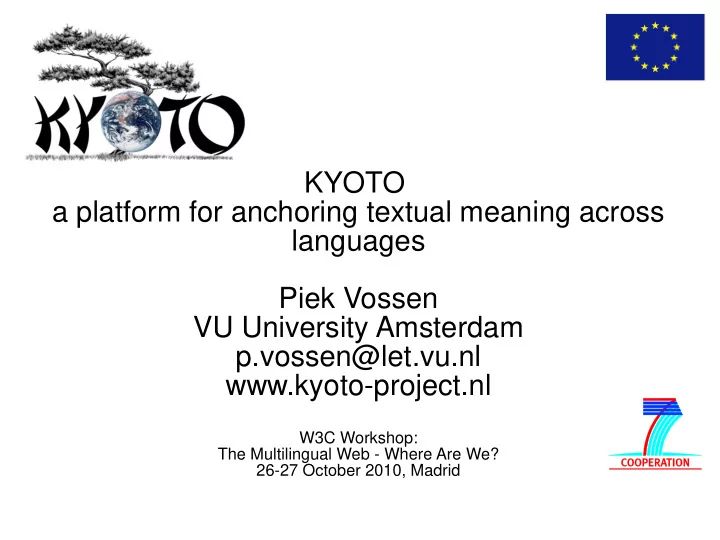

KYOTO a platform for anchoring textual meaning across languages Piek Vossen VU University Amsterdam p.vossen@let.vu.nl www.kyoto-project.nl W3C Workshop: The Multilingual Web - Where Are We? 26-27 October 2010, Madrid
Why translate text if you can mine text and represent the knowledge and information in a language neutral form? W3C Workshop:The Multilingual Web - Where Are We? - 26-27 October 2010, Madrid 2
Warning: older versions of the web are not going to disappear! Evolution of the web W3C Workshop:The Multilingual Web - Where Are We? - 26-27 October 2010, Madrid 3
How to connect different versions of the web? ● Interoperable representation of the structure of language ● Interoperable representation of formal conceptual knowledge ● Methods to map natural language of Web1 and Web2 to the formal interoperable representations that can be used in Web3 and that allow agents to join Web2 in Web4
Basque Japanese Dutch English Spanish Chinese Italian Text Text Text
Basque Japanese Dutch English Spanish Chinese Italian Text Text Text LP LP LP Uniform Uniform Form & structure Form & structure Kyoto Annotation Kyoto Annotation Kyoto Annotation Format Format Format
Basque Japanese Dutch English Spanish Chinese Italian Text Text Text LP LP LP Uniform Uniform Form & structure Form & structure Kyoto Annotation Kyoto Annotation Kyoto Annotation Format Format Format WSD NER ONT Uniform Uniform Geonames Concept & meaning Concept & meaning Vocabularies Kyoto Annotation Ontologies Wordnets Format
Basque Japanese Dutch English Spanish Chinese Italian Text Text Text LP LP LP Uniform Uniform Form & structure Form & structure Kyoto Annotation Kyoto Annotation Kyoto Annotation Format Format Format WSD NER ONT Uniform Uniform Geonames Concept & meaning Concept & meaning Vocabularies Kyoto Annotation Ontologies Wordnets Format Fact Mining Profiles Profiles Profiles RDF
Basque Japanese Dutch English Spanish Chinese Italian Text Text Text LP LP LP Uniform Uniform Form & structure Form & structure Kyoto Annotation Kyoto Annotation Kyoto Annotation Format Format Format WSD NER ONT Uniform Uniform Geonames Concept & meaning Concept & meaning Vocabularies Kyoto Annotation Ontologies Wordnets Format Fact Mining Profiles Profiles Profiles RDF
Basque Japanese Dutch English Spanish Chinese Italian Text Text Text LP LP LP Uniform Uniform Form & structure Form & structure Kyoto Annotation Kyoto Annotation Kyoto Annotation Format Format Format WSD NER ONT Uniform Uniform Geonames Concept & meaning Concept & meaning Vocabularies Kyoto Annotation Ontologies Wordnets Format Fact Mining Profiles Profiles Profiles RDF Language Renderer
Kyoto Annotation Format (KAF) ● Stands off annotation based on Level-2 semantic layers Layered Annotation Format or LAF (Ide and Romary 2002) Level-1 semantic layers – Text: tokenization, sentences, paragraphs, with reference to the source – Terms [Text]: words and multi-words, Dependencies includes parts-of-speech, declension information, etc. Chunks – Chunks [Terms]: constituents & phrases Terms – Dependencies [Terms]: dependency relations between terms Text W3C Workshop:The Multilingual Web - Where Are We? - 26-27 October 2010, Madrid 11
Kyoto Annotation Format Structural KAF <kaf> <text> <wf wid=”w1” page=”1” sent=”1” para=”1” f-offset=”0,4”> large </wf> <wf wid=”w2” page=”1” sent=”1” para=”1” f-offset=”6,14”> migratory </wf> <wf wid=”w3” page=”1” sent=”1” para=”1” f-offset=”16,20”> birds </wf> </text> <terms> <term tid=”t1” type=”open” lemma=”large” pos=”G”> <span id=”w1”/><!-- refers to ”large” (w1) --> </term> <term tid=”t2” type=”open” lemma=”migratory bird” pos=”N”> <span id=”w2”/><span id=”w3”/> </term> </terms> </kaf> W3C Workshop:The Multilingual Web - Where Are We? - 26-27 October 2010, Madrid 12
Structural KAF <kaf> <text>...</text><!-- defines w1, w2, w3 --> <terms>...</terms><!-- defines t1, t2 --> <deps> <!-- dependency: ”large” (t1) → ”migratory birds” (t2) --> <dep from=”t1” to=”t2” rfunc=”mod”/> </deps> <chunks> <!-- two per cent --> <chunk cid=”c1” head=”t2” phrase=”NP”> <span id=”t1”/><!-- refers to term: ”large” --> <span id=”t2”/><!-- refers to term: ”migratory bird” --> </chunk> </chunks> </kaf> 13
Kyoto Annotation Format Semantic layers <term tid="t4" type="open" lemma="population" pos="N"> <span> <target id="w4"/> </span> <term tid="t4" type="open" lemma="population" pos="N"> <span> <target id="w4"/> </span> <externalReferences> < externalRef resource="WN-1.7" reference=" EN-17-00859568-n" confidence="0.80 "/> < externalRef resource="WN-1.7" reference=" EN-17-00257849-n" confidence="0.13 /> < externalRef resource="WN-1.7" reference=" EN-17-00962397-n" confidence="0.07 /> <externalRef resource=“DOLCE" reference=“Group" confidence="0.80"/> </externalReferences> </term> W3C Workshop:The Multilingual Web - Where Are We? - 26-27 October 2010, Madrid 14
Ontotagged KAF <term lemma="water pollution" pos="N" tid="t13444" type="open"> <externalReferences> <externalRef reference="eng-30-14516743-n" confidence="0.8" resource="wn30g"/> <!-- WSD output --> <externalRef reftype="sc_hasParticipant" reference="Kyoto#water"> <externalRef reftype="sc_hasRole" reference="DOLCE-Lite.owl#patient"> <externalRef reftype="sc_subClassOf" reference="DOLCE-Lite.owl#contamination_pollution"> <externalRef reftype="SubClassOf" reference="Kyoto#change-eng-3.0-00191142-n" status="implied"/> <externalRef reftype="SubClassOf" reference="DOLCE-Lite.owl#accomplishment" status="implied"/> <externalRef reftype="SubClassOf" reference="DOLCE-Lite.owl#event" status="implied"/> <externalRef reftype="SubClassOf" reference="DOLCE-Lite.owl#perdurant" status="implied"/> <externalRef> </externalReferences> </term> W3C Workshop:The Multilingual Web - Where Are We? - 26-27 October 2010, Madrid 15
Kybot mining profile <kprofile> <variables> <var name="x" type="term" pos="N" ref="DOLCE-Lite.owl#physical-object"/> <var name="y" type="term" ref="Kyoto#creation" lemma=”! make”/> <var name="z" type="term" ref="DOLCE-Lite.owl#accomplishment" reftype="SubClassOf"/> </variables> <relations> <root span="y"/> <rel span="x" pivot="y" direction="preceding" immediate=”true”/> <rel span="z" pivot="y" direction="following"/> </relations> <events> <event target="$y/@tid" lemma="$y/@lemma" pos="$y/@pos"/> <role target="$x/@tid" rtype="done-by" lemma="$x/@lemma"/> <role target="$z/@tid" rtype="result"lemma="$z/@lemma"/>$ </events> </kprofile> W3C Workshop:The Multilingual Web - Where Are We? - 26-27 October 2010, Madrid 16
Kybot mining output <kybotOut> <doc name="11767.mw.wsd.ne.onto.kaf"> < event eid="e1" lemma="generate" pos="V" target="t3504" synset="eng-30-01621555-v" score=”0.16”> </ event > < role rid="r1" lemma="sceptic system" rtype="done-by" target="t3493" pos="N" event="e1" synset="dw-eng-30-113-n" score=”1.0”/> < role rid="r2" lemma="pollution" rtype="result" target="t3495" pos="N" event="e1" synset="eng-30-14516743-n" score=”0.85”/> </doc> </kybotOut> W3C Workshop:The Multilingual Web - Where Are We? - 26-27 October 2010, Madrid 17
Recommend
More recommend